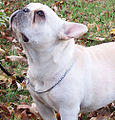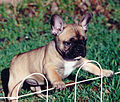The Toy Bulldog and French Bulldog of 1906
An interesting article on the split between Toy Bulldogs and French Bulldogs, and the differences between the French Bulldog breed standards of France, England and America in the 1900’s.
Taken from “The dog book: A popular history of the dog, with practical information as to care and management of house, kennel, and exhibition dogs; and descriptions of all the important breeds“. Written by James Watson, and Published by Doubleday, Page & company, Great Britain, 1906
The French Bulldog
At the time of the war of the ears, when all doggy society hung breathlessly while the momentous question was being decided as to whether it was to be an erect or a rose ear upon the gentleman from France it is a pity that the question of the proper name was not also taken up. At home it is the Bouledouge Francais and as it has not sufficient in common to be a bull dog proper the French name might well have been perpetuated, as it has now been in England, where there is also a toy bulldog which takes care of miniature bulldogs under 20 pounds. The English toy bulldog club was started as an opposition to the Toy Bulldog Club which had decided to recognise bat- ears and dogs up to 28 pounds. This club was recognised as the rightful one to look after the toy bulldog, but after a great deal of trouble the supporters of the bat-eared dog have received recognition and a classification has been made for the Boule-Dogue Francais. This we think is a better title for the dog than what we know it by, the propriety of translating it into English and thus making a bulldog of it being questionable.
Another thing that the club of this country has done is to draw up a standard of its own, making alterations from that of the home club in Paris. When writing on other breeds we have held that the home club is the rightful one to formulate the standard and keep it up to date and that it is not proper for a foreign club to make material alterations so long as the home standard is lived up to at the headquarters of the breed. The Paris club does not grade the colours, merely stating the preference for brindles, and it does distinctly state that black and tans are to be disqualified. Here we have graded colours and anything can be shown. A cut tail is a disqualification in Paris while here it is merely “not desirable.” A cut tailed dog in a breed where cut or docked tails are not proper is a “faked” dog and we are at a loss to know under what circumstances the French bulldog club of this country countenanced the docking of a tail which should be shown naturally
and is only docked when it is not correct in shape or carnage. In the matter of weight our club has also taken upon itself to ignore the French standard. The latter calls for dogs under ten kilogrammes and bitches under nine kilogrammes. The English club while following the French standard very closely did not divide the sexes and says that the weight should be under 24 pounds. The American club has gone on a tack of its own entirely and divided by weight in place of by sex, under 22 pounds for the lightweight class and 22 pounds and over for the heavyweight class. According to that a dog of 26 or 28 pounds is eligible here whereas he would be disqualified in any country in Europe. Alterations such as these cannot be defended and we are left to surmise what the object was in making them.
Whether the boule-dogue Fran9ais owes as much to introductions of toy English bulldog blood as the English writers say is the case we are not prepared to say. What is very evident is that there is a marked difference in certain respects between the boule-dogue and the miniature bulldog as the small English toy bulldog is now called, a term which well expresses what the little dog is. The boule-dogue is not a miniature bulldog any more than the Boston terrier, and the latter in some respects has quite a resemblance to the Parisian dog. So much have they in common that it would not take long to transform one into the other, and that French blood has been introduced into the Boston is more probable than Boston breeders are willing to admit. Knowing what the breeders in Boston have done with the crude material from which they have built up the Boston terrier we do not place a great deal of value upon the claims of English origin as against French cultivation and development of an ideal dog.
From some of the illustrations of English dogs it is evident that many of the breeders and fanciers of that country have not been able to get away from the toy bulldog idea in connection with the French dog and in many of them the rose ear and the receding upper jaw, or protruding under jaw, show the bent of the fancy toward the English toy or miniature bulldog. The establishment of the two clubs in England and the title for the home dog will, however, straighten this matter out and divide the varieties properly. It is somewhat singular that the American club has almost ignored the question of make and shape of the muzzle and jaws, summing all that very important section of the dog in eight words—”jaws large and powerful, deep, square and undershot.” This with the information that the nose must be extremely short and also be very deep from the corner of the eye to the corner of the mouth is all the guide we have to one of the most
important features of the dog in its individuality as distinct from the bulldog. -No person who had not an illustration to guide him could by any possibility- construct in his imagination the dog this standard is supposed to represent in head and any five dog men capable of drawing a dog’s head would all differ from each other in the design they would produce with such a guide. With the illustrations of good dogs as a guide the difficulty is solvable and it will be seen that the muzzle is much on the order of the Boston terrier and has no bulldog lay back or curled up under jaw.
The French bulldog, as we miscall it, has been quite a prominent feature in the toy section of American dogdom for the past fifteen years and the best evidence of his being a good dog about the house is the way those who take up the breed stick to it. Fanciers of the boule-dogue are anything but butterflies but hold to their pets with a persistence that might well be copied by the men who disturb other breeds by getting out before they have hardly had time to settle in the fancy. Not quite so rompy and active as the Boston terrier the boule-dogue is nevertheless as lively in his movements as any dog needs to be about the house, possessing some of the sedateness of the pug in his temperament and disposition. He possesses the advantage which all short coated dogs have of being easily kept clean and fit for the house, requiring only good daily grooming to that end.
Close upon one hundred French bulldogs were benched at the New York show of 1906 and half of these were of American breeding, figures which clearly show the progress and good standing of the breed. That «t is one of the best established was shown by the entries of puppies, 12. dogs and bitches, so there will be no lack of competitors in the immediate future. While competition is close and the quality of the exhibits of a high class there is no preponderating kennel, the prize list being “well broken up ” which is one of the best things for the progress of a breed.
In view of the remarks upon the standards of the French and the American clubs we give that which governs at the home of the breed (ed note: the standard below is the 1906 version of the French Bulldog Standard in France, ie; “That which governs at the home of the breed”).
Descriptive Particulars
General appearance. An active and intelligent dog, very muscular, of compact structure and fairly large bone for its size.
Head.-Very large, broad and square. Skull almost flat; cheek- muscles well developed but not protruding. Eyebrows prominent and separated by a strongly marked furrow; stop very deep. The skin of the head loose, forming almost symmetrical wrinkles and folds.
“Jaws.—Broad, square and powerful, they should never be pointed or pinched. The lower jaw projects, but if too prominent it is a serious fault. The lips should cover the teeth in front and the upper lips or flews should fall below the lower lips at the sides.*
Eyes.—Dark, fairly large, neither sunken nor too prominent, and showing no white when turned toward you. Placed low, wide apart and there should be a good distance from eye to ear. Light coloured eyes are a bad fault, and eyes of different colours are a disqualification.
Nose.—Black, like the lips and muzzle.
Ears.—Erect, known by the name of bat-ears. Medium size, wide at the base and rounded at the points. Placed high on the head, but not too close together and always carried erect. The entire orifice should be seen from the front. Leather soft and fine. Rose ears not admissable.
Chest.—Broad and deep.
Back.—Short, broad and muscular, showing a graceful curve, with the highest point at the loins, and dropping quickly to the tail.
Loins.—Short and muscular, giving plenty of liberty to the movement.
Belly.—Tucked up at the loins; not fat or drooping.
Legs.—Forelegs short, wide apart, straight and muscular. Hindlegs strong and muscular, with hocks well let down.
Feet.—Small, compact and slightly turned out. Toes close and well knuckled up. Short thick nails. Hind feet slightly longer than forefeet.
Tail.—Set on low, thick at root, short and tapering, either straight or screwed and devoid of feather. A gay carriage of tail is a serious fault.
Coat.—Short, close and soft. Should be neither hard nor thin.
Colour.—Dark brindle preferred. Black and tan a disqualification.
Height.—12 inches at the withers.
Weight.—Dogs under 22 pounds; bitches under 20 pounds.
Flews should be pendulous.—J.W.
















